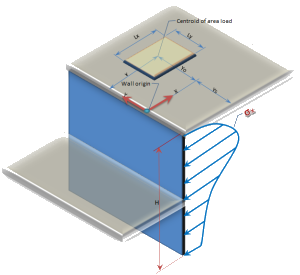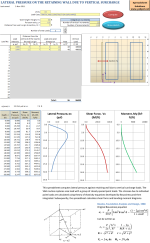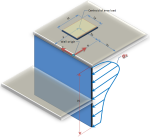Lateral pressure against retaining wall due to surcharge loads

Description
This spreadsheet computes lateral pressure against retaining wall due to vertical surcharge area loads. It handles multiple area loads and uses theory of elasticity equations developed by Boussinesq. Subsequently, the spreadsheet calculates shear force and bending moment diagrams.
Worksheet is protected but without password.
Calculation Reference
Retaining Wall Design
Surcharge Pressure
Geotechnics
When a retaining wall is subjected to vertical surcharge area loads, the lateral pressure against the wall increases. The additional lateral pressure caused by the surcharge is commonly estimated using the Boussinesq's theory for vertical stress distribution in soil. The most common method for calculating the lateral pressure due to a surcharge is the equivalent strip load method.
For a uniform vertical surcharge load (q) acting on the ground surface behind the retaining wall, you can calculate the additional lateral pressure (?P) at any depth (h) below the ground surface using the following equation:
?P = q * K
Where:
- ?P is the additional lateral pressure due to the surcharge (in kPa or psf)
- q is the uniform surcharge load (in kPa or psf)
- K is the lateral earth pressure coefficient
The lateral earth pressure coefficient (K) depends on the type of retaining wall and the soil properties. For an at-rest condition, use the coefficient K0, while for active and passive conditions, use the coefficients Ka and Kp, respectively. These coefficients can be calculated using the Rankine or Coulomb earth pressure theories.
For example, using the Rankine theory, the coefficients can be calculated as follows:
Ka = (1 - sin(φ)) / (1 + sin(φ)) Kp = (1 + sin(φ)) / (1 - sin(φ))
Where:
- φ is the angle of internal friction of the soil
When the surcharge area is not uniform, you can divide it into smaller sections, calculate the additional lateral pressure for each section, and then sum up the pressures to obtain the total lateral pressure due to the surcharge.
It is important to note that this approach simplifies the problem and assumes the retaining wall is rigid, the soil is homogeneous, and the surcharge load is uniformly distributed. In practice, more advanced methods, such as numerical modeling, may be required for complex situations. It is always recommended to consult with a geotechnical engineer familiar with local soil conditions and applicable design codes when calculating lateral pressure against a retaining wall due to surcharge loads.
Calculation Preview
Full download access to any calculation is available to users with a paid or awarded subscription (XLC Pro).
Subscriptions are free to contributors to the site, alternatively they can be purchased.
Click here for information on subscriptions.



